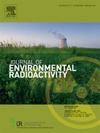人为氚作为主要河流地下水流入的指示器-示踪剂应用的潜力和挑战
IF 2.1
3区 环境科学与生态学
Q3 ENVIRONMENTAL SCIENCES
引用次数: 0
摘要
地下水流入大河对河流总流量的贡献很大。特别是在河流水位较低时,流入的地下水对河流水质的影响较大。因此,地下水流入河流的本地化和量化对于河流的可持续管理至关重要。相应的野外调查通常依赖于基于稳定水同位素(δ2H/δ18O)、自然存在的放射性同位素(例如222Rn)和标准水参数(T、pH、EC)的示踪剂应用。但是,需要对这个示踪工具箱进行扩展。在最近的研究中,人们一直在追求利用核电站上游位置释放的人为氚作为附加示踪剂的想法。该概念假定(实际上不含氚的)地下水和支流水的流入稀释了河流中人为的氚库存量,从而能够量化地下水/支流流入总量(“氚稀释概念”)。由于支流的流入通常很容易量化,因此建议可以从氚数据中得出地下水的流入。在提出的试点研究中,我们调查了这种“氚稀释概念”的适用性,并评估了与输入参数不确定性相关的一般挑战。这项研究是在受核电站工艺用水排放影响的一段延伸河段(伏尔塔瓦河/易北河,捷克共和国)范例地进行的。对相隔168公里的两个监测/测量站记录的两个1个月的氚时间序列进行评估,可以根据氚数据量化该段内流入河流的地下水/支流总量,其精度接近测量到的河流流量增加(分别为+ 72%和+ 77%)。另一方面,从量化的总水量中减去测量的支流入水量后得到的地下水入水量相对较低,因此在方法的不确定范围内。由此可以得出结论,如果所需的输入参数,即天然氚地下水/支流端元和支流排放量足够精确,则“氚稀释概念”是适用的。这一结果对于关注较少扩展的河段的研究是有希望的,这些河段的输入参数更容易定义。本文章由计算机程序翻译,如有差异,请以英文原文为准。
Anthropogenic tritium as indicator for groundwater inflow into major rivers – Potentials and challenges of a tracer application
The inflow of groundwater into a large river can contribute significantly to the total discharge of the river. Especially at low river water level, the inflowing groundwater can strongly influence the river water quality. Therefore, both the localisation and quantification of groundwater inflow into rivers is essential for their sustainable management. Corresponding field investigations usually rely on tracer applications based on stable water isotopes (δ2H/δ18O), naturally occurring radioisotopes (e.g. 222Rn) and standard water parameters (T, pH, EC). However, an extension of this tracer toolbox is desirable. In recent studies, the idea of using anthropogenic tritium that is released from a nuclear power plant (NPP) at an upstream location as an additional tracer has been pursued. The concept assumes that the inflow of (practically tritium-free) groundwater and tributary water dilutes the anthropogenic tritium inventory of the river and thus enables quantification of the total groundwater/tributary inflow (“tritium dilution concept”). Since the inflow of tributaries is usually easy to quantify, it is suggested that the inflow of groundwater can be derived from the tritium data. In the presented pilot study, we investigated the applicability of this “tritium dilution concept” and evaluated the general challenges associated to the uncertainty of input parameters. The study was executed exemplarily at an extended river section affected by the release of NPP process water (Vltava/Elbe River, Czech Republic). The evaluation of two 1-month tritium timeseries recorded at two monitoring/gauging stations 168 km apart allowed quantifying the total groundwater/tributary inflow into the river within this section based on the tritium data with a precision that was close to the gauged increase in river discharge (+72 % and +77 %, respectively). On the other hand, the groundwater inflow that was derived after subtracting the gauged tributary inflow from the quantified total water inflow was comparably low and therefore within the approaches’ range of uncertainty. From this it can be concluded that the “tritium dilution concept” is applicable if the required input parameters, namely the natural tritium groundwater/tributary endmember and the tributary discharge, are known with sufficient precision. This outcome is promising for studies that focus on less extended river sections with input parameters that are easier to define.
求助全文
通过发布文献求助,成功后即可免费获取论文全文。
去求助
来源期刊

Journal of environmental radioactivity
环境科学-环境科学
CiteScore
4.70
自引率
13.00%
发文量
209
审稿时长
73 days
期刊介绍:
The Journal of Environmental Radioactivity provides a coherent international forum for publication of original research or review papers on any aspect of the occurrence of radioactivity in natural systems.
Relevant subject areas range from applications of environmental radionuclides as mechanistic or timescale tracers of natural processes to assessments of the radioecological or radiological effects of ambient radioactivity. Papers deal with naturally occurring nuclides or with those created and released by man through nuclear weapons manufacture and testing, energy production, fuel-cycle technology, etc. Reports on radioactivity in the oceans, sediments, rivers, lakes, groundwaters, soils, atmosphere and all divisions of the biosphere are welcomed, but these should not simply be of a monitoring nature unless the data are particularly innovative.
 求助内容:
求助内容: 应助结果提醒方式:
应助结果提醒方式:


